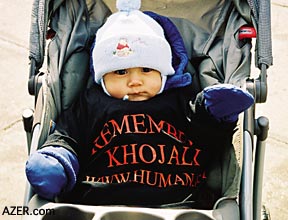|

Spring 2005 (13.1)
Page 19
Facts About Khojali
by Thomas Goltz
See other articles
by Thomas Goltz:
Khojali: Eyewitness
Account From the Following Day (1992)
Khojali: A
Decade of Useless War Remembered
Khojali:
13
Years Later: Remember, But Be Sure to Preserve Your Souls
Khojali: How
to Spell "X-O-J-A-L-I"?
  The year 1988 is generally
accepted as the beginning of the conflict between Armenia and
Azerbaijan over Karabakh. The fighting eventually petered out
to a bitter "no war"/"no peace" ceasefire
in May 1994. The year 1988 is generally
accepted as the beginning of the conflict between Armenia and
Azerbaijan over Karabakh. The fighting eventually petered out
to a bitter "no war"/"no peace" ceasefire
in May 1994.
Left: On February 25, 2005,
Azerbaijanis in the Washington, D.C. area demonstrated in front
of the Armenian Embassy to protest the 1992 Khojali massacre
and to condemn Armenia's continued occupation of Azerbaijan.
Virtually everything since then has been disputed between the
two sides - the numbers of those killed or wounded, the number
of those forced to flee their homes (and the reasons why), and
even the amount of Azerbaijani territory currently under Armenian
occupation.
A recent report by the Parliamentary Assembly of the Council
of Europe (PACE) urged Armenia to cease its occupation. Armenia
responded by denying that it was occupying any Azerbaijani land
at all, insisting that local Karabakh Defense Forces were responsible
and that Yerevan had no control over them.
Khojali (which has numerous spellings including Khojaly, Xocali,
Hojali, Hodjali, etc.) had an official population of about 10,000
in 1992. It was the first major Azerbaijani settlement overrun
by Armenian forces in Mountainous Karabakh (Nagorno Karabakh)
on February 25-26, 1992. Then followed the towns of Shusha and
Lachin, which are outside the administrative borders of the Mountainous
Karabakh Autonomous District (often referred to as "NK"
in the literature), and then other "valley" Karabakh
"rayons", or districts in Azerbaijan proper: Zangilan,
Gubadli, Fuzuli, Aghdam and Kalbajar. Altogether, these territories
represent some 15 percent of the territory of Azerbaijan.
The official percentage number cited by the authorities in Baku
is 20 percent, which is a number that was rounded higher for
political reasons and, thus, is disputed by Armenians, who claim
that they are "only" occupying some 9 percent of Azerbaijani
territory because they exclude "NK" from the total.
Those "valley" Karabakh territories were effectively
"ethnically cleansed" of some 800,000 Azerbaijani residents
during the course of the war. Recent satellite photography of
many towns and settlements in the occupied territories reveal
substantial building of new structures in and among the burnt
shells of the ruins of war. Such activities are in direct violation
of the Geneva Conventions which define what an occupying force
may do. The suggestion is that the Armenian authorities are moving
in settlers to create a "fait accompli" human rights
issue if, and when, an international settlement is ever imposed.
For further
reading, see "Azerbaijan Diary" (M.E. Sharpe 1998/99)
by Thomas Goltz, or the more recent and Karabakh - specific "Black
Garden" by Tom de Waal, New York University Press, 2003.
Goltz's articles about Khojali can be found in Azerbaijan International
magazine. "Khojali: Eyewitness Account from the Following
Day" and "Khojali: A Decade of Useless War Remembered".
Both are published in AI 10.1 (Spring 2001). Search at AZER.com.
Back to Index AI 13.1 (Spring
2005)
AI Home
| Search | Magazine
Choice
| Topics
| AI Store | Contact us
Other Web sites
created by Azerbaijan International
AZgallery.org | AZERI.org | HAJIBEYOV.com
|